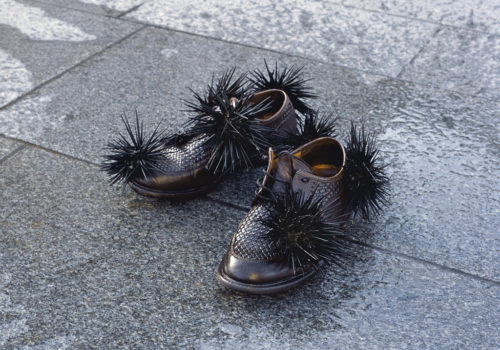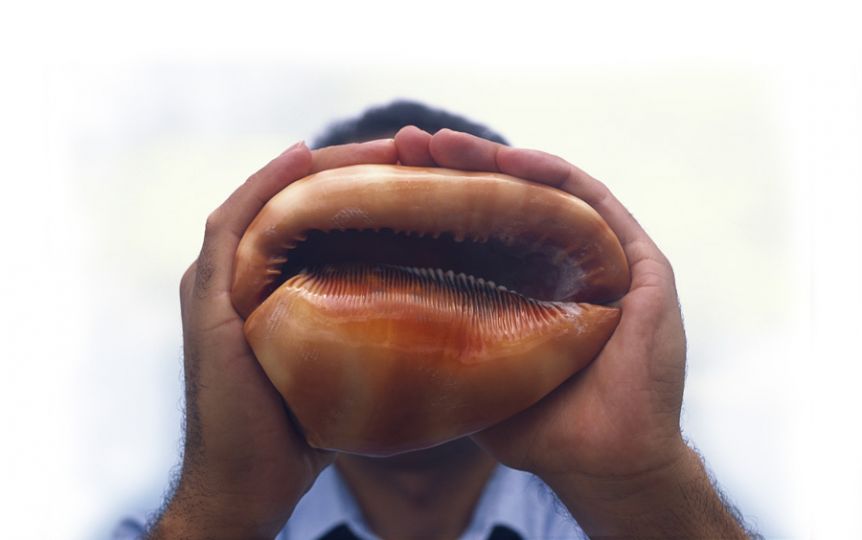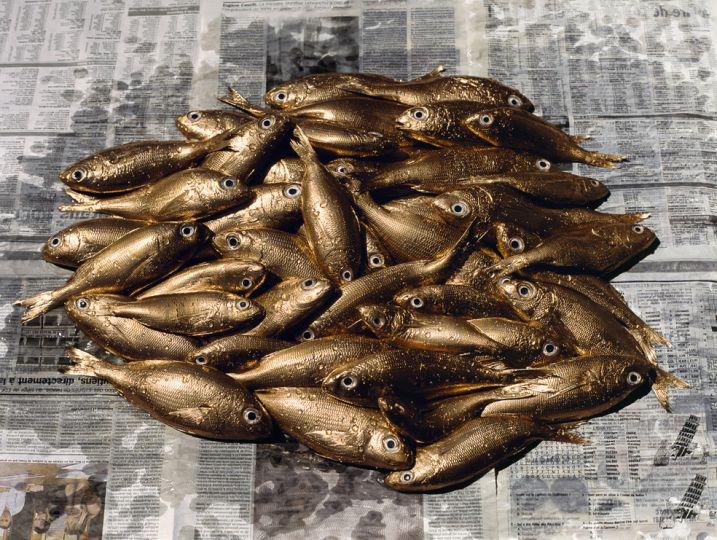Thierry Fontaine plays with what makes an image, trying to change the semantics of it, the way other French artists from the 1980’s and 1990’s did, redefining the status of the image and broadening the possibilities of various visual interpretations. This conceptual stand reminds us of singular works such as Jean-Luc Moulène’s or Paul Pouvreau’s. Both modify in their own way the common objective depiction to question our perception not only of the subject inside an image but rather of the “image itself”, using principles of nesting dolls that deliberately mix the pattern, the reality they photography and the image they shoot. This process leads us to constantly go back and forth between the visual object and the semeiological references. Sense-making –a necessary process to penetrate a piece and potentially grasp its full meaning making it your own- can only happen in a mental space that one can define as aesthetical, depending on a complicity between the author and his game.
In Thierry Fontaine’s work, several perceptive layers are produced simultaneously by the image’s symbols, by its poetic charge, and by the manner in which the artist gives birth to it. He goes far, using tools to create his own very special image-craft, his “fabrique de l’image” as one would say in French. This fashionable term has a literal meaning in this context since the artist can be considered as a craftsman in the sense that he meticulously prepares the tools of his staged scene, one by one, with much effort. He designs, or sometimes finds people to carry out the task, the necessary objects for his image then goes through several trials until he reaches the perfect visual desired result. He can thus spend days or months braiding rope on a wire fence in order to picture the effect of the fire when it lits it (Johannesburg, 2009). Impossible effect but oh so subjective for a transcendental image, in which the gigantic size of the print (3m50 wide) reinforces the spectacular aspect of it.
From time to time, he goes to a remote place in the world, creating objects that convey the idea of a different exoticism. Vers le but (Towards the goal, 2006), for example, is based on a technic of crocheted net with shells designed to hold footballs. The reference to a common object is obvious but modified by the outside material whose symbolic connotation creates an unheard of metaphor. Beyond the vision, a poetic dimension resounds with the artist’s culture and his origins that evoke the other side of the word, and his eternal wanderings. If Thierry Fontaine is a total contemporary artist whose work echoes occidental stronger stands, he is linked to his culture, pointing to us in passing the place he comes from but also the one our society assigned to him . Doing so, he tells us of exoticism and brings up our perceptive codes in a socio-political way, putting emphasis on the prejudices that imprison them. Nevertheless Fontaine tries to avoid at all costs- what could be considered as politically correct. His elegance disarms the cynicism of some or the attempt of others to use his work to their own advantage because he knows exactly where he stands and where his work is heading to, just like Edouard Glissant, the poet from Martinique who just passed away, did. In La Longue Traversée (The Long Crossing, 2005), he designed elegant plaited mocassins covered in sea urchins floating in a sea pond on the tarmac. With this visual offer, he suggests the exile and attraction to the mainland. Nothing however reminds us of the impoverishment and postcolonial subjection of the overseas population. He gives a rough ride and disavows the innuendoes that often go with our understanding of the subject. On the contrary, he evokes rather an artistic dandysm and a transgressive liberty.
The artist also presents us with an original image of our exotic tourism with a photograph of a dark skinned-pseudo-seller that creates souvenirs, painting footballs on coconuts – Le Fabricant de Rêves (The Dream Manufacturer, 2008). In another scene (Souvenirs, 2009), the “stallholder”sells sea-shell Eiffel towers. In another setting of the same kind, a character trades wooden dildos that act as symbols for our obscure desires for appropriation between lingam khmer and African statues (Avant la Cérémonie, Before the Ceremony, 2013).
Those situations imply an abrupt question on how it is possible to determine who is the seller and who offers the other an illusion of happiness. Is it us, Westerners, that force the rest of the world to give credit to our set of values? Or is it this casual indigenous that tries to sell each tourist his own reflection luring him into the mirror of desire?
In the end, it is neither of them: nobody’s supposed to answer this since Thierry Fontaine elevates and transfigures our sociocultural frictions. His art submerges the meaning and prevents us from having to choose. As visual thoughts that tend to reunite, his stages scenes are not only beautiful, but also and mostly calm. Those seductive images are tinged with an atmosphere of an elsewhere whose rules are manipulated by the artist to change the angles of our perceptions and to make us laugh at ourselves. He tells us surreptitiously his “intimate views on elsewhere” in a sublimated version of the trinkets we love to buy.
For some pieces, Thierry Fontaine creates a scene from a character. He can use a model but at times when it was needed, he himself embodied the image, becoming the “performer” of that image. In those cases, the sculptural reference directly comes to mind in the sense that heads or bodies are often covered with clay. This red ochre also possibly refers to the genesis of the Being and to the original soil and, from there, calls upon the ground of the island he was born on. Some images hold our attention: the body of a man that has a sculpture in his hands in La Fleur de l’île (The Flower of the Island), or the scream that comes from a clay head, or even that beheaded body rising from an enchanted jungle, covered with clay like an exotic San Sebastian… He uses his body as an an anonymous figure, in a factual way, or at least as an archetype and definitely not as a self-portrait because the face is always concealed. The body conveys the image’s meaning, it becomes its architecture but not its subject. If the artist plays with the performance, he avoids any potential identification, projection or desire. His figure remains the sole human element and he never resorts to proselytism.
If at times the image seems to render the semantics of the artwork quite easily, on other occasions it is difficult to comprehend it. The artist apparently enjoys leading us astray and letting us slide into the numerous interstices of his images. In one of his compositions, Trésor (Treasure, 2008), Thierry Fontaine covers plastic bottles in golden paint so that they might mimic a hidden treasure. He shoots them in a rocky pseudo aquatic environment that plays as a trompe-l’oeil with the stones’ colours, highlighting the gold and silver of the objects. The artist later re-photographs the print under water, creating a visual inexpressible volatility that prevents us from fully grasping the image’s meaning. The artist gives us a false image of a false treasure, discovered in a fake sea… What would be the point of it if not to appeal to our imagination? He forces us discretely, therefore, to comprehend the complexity of the creation process while inviting us to let go of it. He goes beyond and even derides the conceptual dialectics as if the artist reduced the analytical potential by transforming it into a semantic subterfuge, therefore acting the way a bluffer would. Nothing cynical however, he refers rather to the magic of an evocation and to a process of transfiguration as a part of mystery . When one decides to let go of all conceptual tools, the beauty and the symbolic potential of the images eventually strike us. The true power of Thierry Fontaine’s universe suddenly appears brightly.
His friend Gilles Clément states that his pieces are “subversive”. The first reaction would be to reject this expression but, looking at it closely, the term becomes effective. It can define his conceptual stand in its complex and, as we said, unorthodox dimension. This might disqualify the artwork or at least push it towards a dead-end if it did not lead us towards another kind of composition that flirts with sublimation.
What is the nature of Troisième Souffle (Third Breath, 2006)? A tree trunk nurtured on grey rich bark a bloody excrescence of three hearts, admittedly animals’ hearts but that literally bring to mind human hearts. The Cibachrome image gives a discret metal emphasis on the contrasts and the blacks, almost creating a monochrome from which only the bloody cochineal red violently emerges. Paradoxically, we’re drawn to its beauty. The wink turns into a visual trompe-l’oeil and reference source that insidiously arouses a retinal fantasy. The image exceeds its pattern and gains an “atrociously beautiful” aura likely to wake our subconscious up at night.
With this piece, the artist deserts the shores of his friend Edouard Glissant’s to reach the stream that evokes the Chants de Maldoror (The Songs of Maldoror). Le Troisième Souffle (The Third Breath) seems to personify the “evil” and “dolor” or the “mal d’aurore” of the
Comte de Lautréamont, alias Isidore Ducasse, an Uruguayan poet and magnificent foreigner that resorted to the fierceness of the French language and to its mythical poets to celebrate the beauty and desire that come out of darkness.
The same delight for black eroticism can be found in Thierry Fontaine’s work. In the same train of thoughts, what is the effect of the baroque device that associates two images, Trésor (Treasure) and Le Troisième Souffle (The Third Breath) on a background of bloody foam taken from the image Terre 2006) used on that occasion as wallpaper? This combination creates a visual choc that re-enhances the notion of beauty and bows out towards the influence of the great Baroque who used crimson red as one of their favourite colours, with lapis blue (marine here with Fontaine). It is a visual device that the artist often uses in his installations because, if he creates his images in monumental sizes, he also appreciates the idea of acting directly on the architectural space to twist our perception. Using this blood puddle on wallpaper that swallows up our gaze in its colour and density, the aesthetical attempt of subversion is obvious –especially when one considers the contemporary art scene that tends to ignore what is baroque or accepts it only occasionally. It becomes the synonym of a “visual ecstasy” in this scenography that revives the aesthetic quest for beauty that sits on the verge –and why shouldn’t it?- of a fascinating morbid and rebel sensuality that moves the images. To charge Thierry Fontaine with mannerism would be like omitting the reality he suggests through the photographic and visual power as well as the inexpressible elegance his commitment includes.
Christine Ollier
http://www.fillesducalvaire.com


















